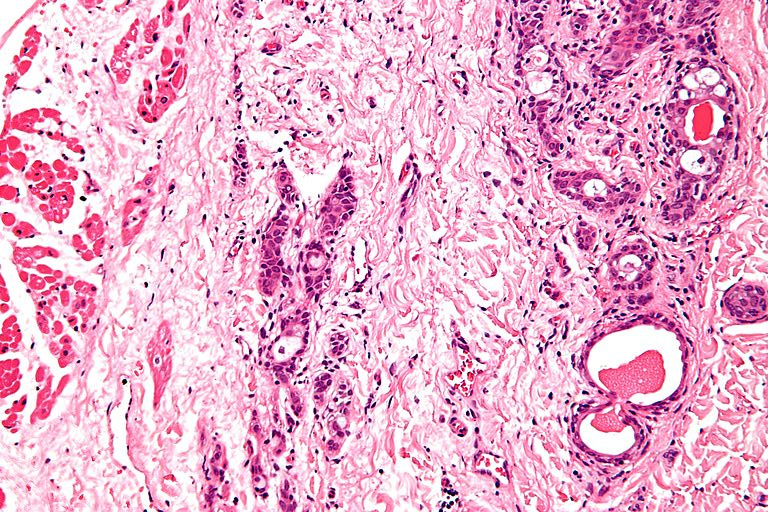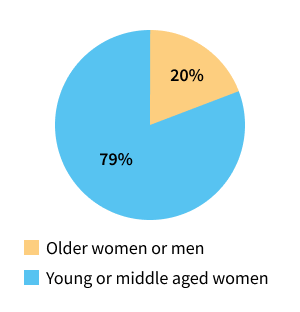Get in Touch
Have questions? Call or chat with our Patient Advocates for answers.
Cystic mesothelioma is an exceedingly rare and noncancerous disease that typically develops in epithelial cells of the abdomen in young women. This condition is also called benign multicystic peritoneal mesothelioma. About 150 cases have been reported in worldwide medical literature as of 2022.

Written by Karen Selby, RN | Medically Reviewed By Dr. Andrea Wolf | Edited By Walter Pacheco | Last Update: June 27, 2024
Cystic mesothelioma is a benign form of mesothelioma. It develops in the peritoneum, the layer of tissue that lines the abdominal organs. It is also known as benign multicystic peritoneal mesothelioma.
This disease is not considered cancer. However, it can progress into an aggressive malignancy in some patients. The benign variant is more common and an intermediate form of mesothelioma.
Medical experts classify cystic mesothelioma as less dangerous than the diffuse epithelial variant. However, it is more severe than localized benign adenomatoid mesothelioma.

Most cases develop in the pelvic peritoneum (the lining of the lower abdominal cavity) of women under 40. Most other subtypes of mesothelioma develop in men. These lesions can also develop in pelvic structures such as the omentum, uterus, bladder and rectum. In unusual cases, it can also grow in the liver.
A case study from January 2022 reported on a 32-year-old woman who presented with abdominal pain. CT scans showed a lesion with surrounding inflammation near her colon. She underwent surgery to remove the lesion. The biopsy revealed multicystic peritoneal mesothelioma.
Unlike malignant mesothelioma, the link between asbestos exposure and cystic mesothelioma is unclear. Some studies suggest cystic mesothelioma develops in response to foreign fibers and dust. Another possible cause is chronic irritation, such as prior surgery or endometriosis. Other studies suggest that female sex hormones can trigger its development.
Most symptoms involve abdominal or pelvic pain, bloating or cramps. Other symptoms can include changes in urinary or bowel habits.
Most patients do not experience symptoms until the tumor is large enough to impact other organs. A 2018 case report published in Case Reports in Surgery confirmed this factor.

Gain access to top mesothelioma doctors and get help scheduling appointments.
Connect NowSmooth, thin-walled cysts characterize benign multicystic peritoneal mesothelioma. Fragile fibrovascular tissue holds the cysts together, and the individual cells are flat or cube-shaped.
The cysts can fill with mucinous or gelatinous fluid and may grow as large as 20 cm in diameter. On imaging scans, doctors may be able to see separate “chambers” in the cystic tumor. When removed from the body, the tumors may appear pale yellow.
Unlike many types of cancer, cystic peritoneal mesothelioma does not spread or metastasize to other body systems. It is a localized tumor.
The best way to diagnose cystic mesothelioma is by performing a biopsy with a laparoscopy technique. This minor surgical procedure uses a thin tube fitted with a light and camera. A CT scan, ultrasound or MRI can visualize tumors, but these tests can’t confirm a diagnosis.
Patients often report pelvic or lower abdominal pain and weight loss as the first signs of the disease. Doctors perform a standard physical exam. They also order imaging scans to learn about the underlying cause of these symptoms.
Doctors can spot abnormal growths and collect tissue samples through a small incision in the abdomen. The tissue is then sent to the lab for testing, where a pathologist, a doctor specializing in cellular changes, can confirm a diagnosis.
Doctors find it difficult to diagnose the disease because of its rarity. The diagnosis often develops from a doctor’s visit for a different medical issue.
Doctors who are not mesothelioma specialists may misdiagnose it. Cystic mesothelioma looks like malignant mesothelioma and other types of benign growths. There are a few ways to distinguish between cysts that look similar.
Malignant mesothelioma typically forms calcified plaques or nodules, while cystic mesothelioma forms liquid-filled cysts. The cells in malignant mesothelioma tumors also display increased activity, which doctors detect with immunohistochemical staining.

Learn about your diagnosis, top doctors and how to pay for treatment.
Get Your Free GuideSurgery is the only effective treatment for cystic mesothelioma. The first step of the treatment plan is the complete surgical removal of benign cystic mesothelioma. A 2021 article in the International Journal of Surgery Case Reports confirmed this.
A 2022 case study described a woman treated with cytoreductive surgery followed by HIPEC. The treatment could treat peritoneal benign cystic mesothelioma and prevent its malignant transformation.
Because this type of cancer grows slowly and does not spread, its prognosis is much better than other forms of the disease. As of 2009, only one patient had died from the benign variation of the condition, and this patient had elected not to undergo surgical resection.
About half of all patients will experience a recurrence. After diagnosis, patients must undergo routine follow-up imaging to monitor cancer progression.
Recommended ReadingYour web browser is no longer supported by Microsoft. Update your browser for more security, speed and compatibility.
If you are looking for mesothelioma support, please contact our Patient Advocates at (855) 404-4592
The Mesothelioma Center at Asbestos.com has provided patients and their loved ones the most updated and reliable information on mesothelioma and asbestos exposure since 2006.
Our team of Patient Advocates includes a medical doctor, a registered nurse, health services administrators, veterans, VA-accredited Claims Agents, an oncology patient navigator and hospice care expert. Their combined expertise means we help any mesothelioma patient or loved one through every step of their cancer journey.
More than 30 contributors, including mesothelioma doctors, survivors, health care professionals and other experts, have peer-reviewed our website and written unique research-driven articles to ensure you get the highest-quality medical and health information.
My family has only the highest compliment for the assistance and support that we received from The Mesothelioma Center. This is a staff of compassionate and knowledgeable individuals who respect what your family is experiencing and who go the extra mile to make an unfortunate diagnosis less stressful. Information and assistance were provided by The Mesothelioma Center at no cost to our family.LashawnMesothelioma patient’s daughter


Selby, K. (2024, June 27). Cystic Mesothelioma. Asbestos.com. Retrieved October 21, 2024, from https://www.asbestos.com/mesothelioma/cystic/
Selby, Karen. "Cystic Mesothelioma." Asbestos.com, 27 Jun 2024, https://www.asbestos.com/mesothelioma/cystic/.
Selby, Karen. "Cystic Mesothelioma." Asbestos.com. Last modified June 27, 2024. https://www.asbestos.com/mesothelioma/cystic/.
A medical doctor who specializes in mesothelioma or cancer treatment reviewed the content on this page to ensure it meets current medical standards and accuracy.
Please read our editorial guidelines to learn more about our content creation and review process.
Dr. Andrea Wolf is the Director of the New York Mesothelioma Program at Mount Sinai in New York City. She focuses on multidisciplinary treatment, clinical research, community outreach and education.
Mesothelioma Center - Vital Services for Cancer Patients & Families doesn’t believe in selling customer information. However, as required by the new California Consumer Privacy Act (CCPA), you may record your preference to view or remove your personal information by completing the form below.
